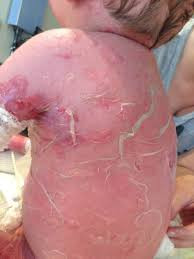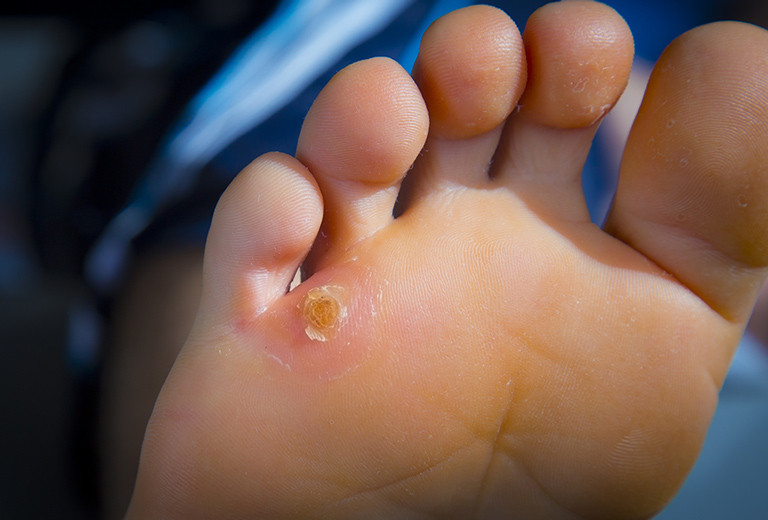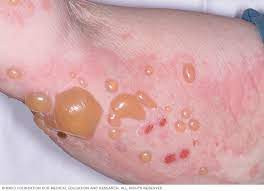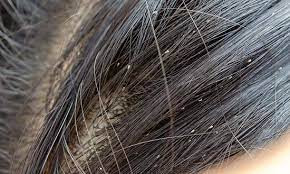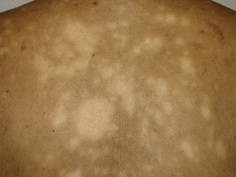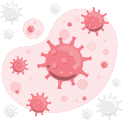Definition
Toxic epidermal necrolysis (TEN) is a severe hypersensitivity reaction of the skin, typically triggered by medications. This hypersensitivity occurs when the immune system, instead of protecting the body, launches an excessive response against healthy tissues or harmless substances, leading to tissue damage. Though rare, TEN is life-threatening, characterized by blistering and peeling skin that mimics burns.
TEN is considered a more severe condition than Stevens-Johnson Syndrome (SJS), another hypersensitivity reaction marked by blistering. The peeling of the skin is classified as TEN when it affects more than 30% of the body surface, accompanied by extensive damage to the mucous membranes. In contrast, SJS affects no more than 10% of the body surface. TEN can strike individuals of all ages.
As the skin acts as the body’s first defense against bacteria and microbes, the damage caused by TEN can lead to serious complications, such as severe lung infections or those that spread through the bloodstream. Immediate medical intervention is crucial. Hospitalization is often required, as supportive care is needed to manage pain, treat wounds, and ensure adequate hydration. Recovery can take weeks or even months.
Causes
The hypersensitivity reaction seen in TEN is usually triggered by drugs or infections, though in many cases, the cause remains unknown. Immunizations and organ transplants, while rare, can also provoke TEN. Symptoms typically appear one to four weeks after the introduction of a new medication. Drugs known to trigger SJS/TEN include:
- Sulfonamide antibiotics, such as co-trimoxazole
- Beta-lactam antibiotics, such as cephalosporins
- Anticonvulsants, such as carbamazepine, phenobarbital, and phenytoin
- Paracetamol
- Allopurinol, often used in treating excessive uric acid
- Nevirapine, used in HIV treatment
- Nonsteroidal anti-inflammatory drugs (NSAIDs), such as meloxicam or piroxicam
Other potential triggers include infections or malignancies, such as:
- Viral infections: cytomegalovirus, herpes simplex, hepatitis A, COVID-19
- Bacterial infections: Mycoplasma pneumoniae
- Lung or liver cancer
Risk factor
While anyone can develop TEN, certain individuals are at higher risk, including those with:
- Weakened immune systems
- Organ transplant recipients
- HIV/AIDS
- Autoimmune diseases
- Those undergoing treatments that suppress the immune system
- Cancer
- A personal or family history of SJS/TEN
- Genetic factors
Symptoms
TEN typically begins with symptoms similar to an upper respiratory tract infection, lasting from one day to three weeks, such as:
- Fever exceeding 38°C
- Fatigue
- Sore throat
- Cough and runny nose
- Muscle and joint pain
- Red, painful eyes
- Loss of appetite
- Nausea and vomiting
Following these symptoms, mucosal reactions manifest, causing pain and heat sensations. Depending on the affected mucous membranes, additional symptoms may include:
- Eyes: redness or sensitivity to light
- Mouth or lips: red, dry, peeling lips, or mouth ulcers
- Throat: difficulty swallowing
- Urinary tract and genitals: sores and difficulty urinating
- Respiratory tract: cough and shortness of breath
- Digestive tract: diarrhea
Skin symptoms usually appear one to three days after mucosal involvement. Rashes may suddenly develop on the chest, abdomen, or back, rapidly spreading to the face, arms, and legs within four days. These rashes can present as red patches, blisters filled with fluid that easily burst, or various combinations thereof, all accompanied by pain.
The characteristic skin lesions in TEN are large blisters that merge, causing the outermost skin layer to peel away, exposing the raw, moist middle layer. Sores, swelling, and hardened skin may also affect the mucous membranes, including the mouth, eyes, and vagina.
TEN is a debilitating condition. Patients endure intense pain, which can cause agitation. Other organs, including the liver, kidneys, lungs, bone marrow, and joints, may also be affected.
Diagnosis
TEN is diagnosed when more than 30% of the body surface is affected by the SJS-like reaction. Doctors begin by reviewing symptoms, medical history, family history, and current medications. A physical examination follows to assess the severity and extent of the damage.
While a diagnosis can often be made based on history and physical examination alone, additional tests may include:
- Skin biopsy: a sample of the skin is examined under a microscope to confirm the diagnosis
- Blood and urine tests: used to detect complications like nutritional deficiencies and estimate recovery prospects
Management
If a medication is suspected as the cause of TEN, it must be permanently discontinued. Hospitalization, often in intensive care, is typically required. Full recovery may take several months.
Supportive Care
Supportive care for TEN patients during hospitalization includes:
- Fluid and Nutritional Therapy
Skin damage can result in significant fluid loss, necessitating fluid and electrolyte replacement. Patients receive fluids and nutrients via a nasogastric tube or intravenously. - Wound Care
Healthcare professionals clean the affected areas and apply specialized dressings infused with petroleum jelly or medications. Antibiotics are administered if the wounds become infected. - Respiratory Support
In severe cases, intubation or other breathing assistance may be needed to keep airways clear. - Pain Management
Patients are given analgesics to alleviate discomfort. Numbing mouthwashes may be prescribed for oral pain. - Eye Care
For mild eye symptoms, artificial tears are used several times a day. Corticosteroid eye drops may be prescribed to reduce inflammation.
Surgical Procedures
In cases where medication is ineffective, surgical interventions such as debridement and skin grafting may be performed. Debridement involves removing dead tissue from wounds, while skin grafting uses healthy skin from other body parts or a donor to cover areas of severe skin damage.
Self-Care
After discharge, patients must follow a self-care regimen that includes:
- Caring for wounds as advised by their doctor to speed healing and prevent infection
- Maintaining oral hygiene by brushing gently or using medicated mouthwash
- Staying hydrated to prevent dehydration
- Engaging in physical therapy to improve muscle function, strength, and alleviate pain
Typically, recovery takes between three to six weeks.
Complications
The highest risk of complications occurs in individuals over 70, those with liver cirrhosis, or advanced-stage cancer. Complications of TEN may include:
- Widespread blood infections (sepsis), potentially leading to organ failure
- Respiratory issues, such as persistent coughing, difficulty breathing, or respiratory failure
- Vision problems, ranging from dry eyes and ingrown eyelashes to corneal scarring or blindness
- Permanent skin damage or long-term dermatological problems
- Vaginal sores
- Emotional distress with long-lasting psychological effects
- Taste disturbances
- Malnutrition
- Ulcers in the stomach or other parts of the digestive tract
- Blood clotting disorders
Prevention
To prevent the recurrence of TEN, it is crucial to identify whether the condition was drug-induced. Once a triggering medication is identified, it must be permanently avoided. Recurrence can be more severe and life-threatening. Inform healthcare providers of any known drug allergies or adverse reactions whenever seeking medical care.
Although TEN cannot be completely prevented, its risks can be minimized by consulting with a doctor before taking any medication, especially for individuals at higher risk of TEN.
When to see a doctor?
Early intervention is key in treating TEN. The skin reactions associated with TEN are quite apparent, so if you experience any of the aforementioned symptoms, seek immediate medical assistance at the nearest emergency department.
Looking for information about other diseases? Click here!
- dr. Yuliana Inosensia
TEN. (2020). Retrieved 27 April 2022, from https://www.mayoclinic.org/diseases-conditions/toxic-epidermal-necrolysis/symptoms-causes/syc-20491903
Cohen SPJ. (2021). Toxic epidermal necrolysis (TEN). Retrieved 27 April 2022, from https://emedicine.medscape.com/article/229698-overview
Toxic epidermal necrolysis: causes, symptoms, and treatments. (2021). Retrieved 27 April 2022, from https://www.webmd.com/skin-problems-and-treatments/what-is-toxic-epidermal-necrolysis#
Nunez K. (2019). What is toxic epidermal necrolysis (TEN)?. Retrieved 27 April 2022, from https://www.healthline.com/health/toxic-epidermal-necrolysis#
Labib A, Milroy C. (2021). Toxic epidermal necrolysis. Retrieved 27 April 2022, from https://www.ncbi.nlm.nih.gov/books/NBK574530/
Toxic epidermal necrolysis (TEN). Retrieved 27 April 2022, from https://my.clevelandclinic.org/health/diseases/21616-toxic-epidermal-necrolysis-ten

